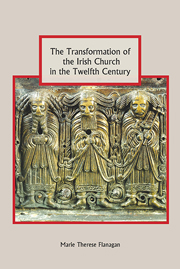Book contents
- Frontmatter
- Contents
- Acknowledgements
- Abbreviations and short titles
- Introduction
- 1 Charting change in the twelfth-century Irish church: the problem of sources
- Bishops and dioceses
- Varieties of monasticism
- 4 ‘Restoring the monastic and canonical rules of the church in Ireland’: St Malachy and monastic reform
- Lay society
- Conclusion: Universal ideals and regional responses
- Bibliography
- Index
4 - ‘Restoring the monastic and canonical rules of the church in Ireland’: St Malachy and monastic reform
from Varieties of monasticism
Published online by Cambridge University Press: 05 October 2013
- Frontmatter
- Contents
- Acknowledgements
- Abbreviations and short titles
- Introduction
- 1 Charting change in the twelfth-century Irish church: the problem of sources
- Bishops and dioceses
- Varieties of monasticism
- 4 ‘Restoring the monastic and canonical rules of the church in Ireland’: St Malachy and monastic reform
- Lay society
- Conclusion: Universal ideals and regional responses
- Bibliography
- Index
Summary
One of the most distinctive features of the religious revival that gathered pace throughout Europe from the eleventh century onwards was the great variety of interpretations of the religious life that emerged in a relatively short time-span. The proliferation of diverse interpretations of the monastic life had initially created, in the words of Pope Urban II, ‘a schism in the house of God’. Although, at first, there had been tensions between old and new monks, a gradual acceptance of variety emerged and the positive value of ‘diversity but not adversity’ had come to be accepted by the mid twelfth century, by which time both Augustinian and Cistercian monasticism had been introduced to the Irish church, each promoted in equal measure by Malachy, whose interest in more than one Continental monastic observance reflects that twelfth-century engagement with different interpretations of the monastic life.
Malachy's first encounter with the religious life had been under his spiritual mentor, Imar Ua hÁedacáin, at Armagh, to whose ‘pattern of life (forma vitae)’ he submitted himself and from whom he learnt ascetic discipline and humility. Following his ordination as a priest Malachy then went to study under Bishop Máel Ísu (Malchus) Ua hAinmire at Lismore, so as to ensure that he would be properly informed ‘regarding divine ritual and the veneration of the sacraments’ lest he should teach anything that went counter to the universal church, and to learn from Máel Ísu his ‘way of life and his teaching (vita et doctrina)’.
- Type
- Chapter
- Information
- The Transformation of the Irish Church in the Twelfth Century , pp. 118 - 168Publisher: Boydell & BrewerPrint publication year: 2010



